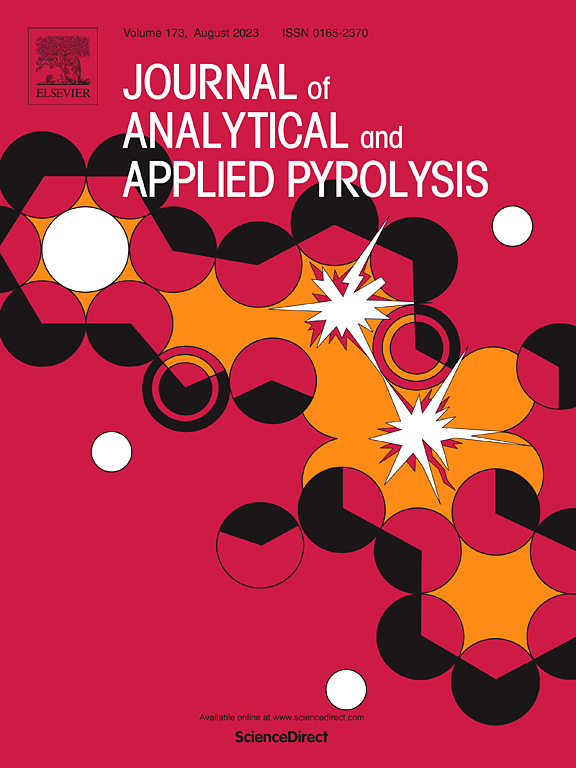Understanding limonene synthesis from waste tire pyrolysis through a kinetics-based perspective
IF 6.2
2区 化学
Q1 CHEMISTRY, ANALYTICAL
引用次数: 0
Abstract
The pyrolysis of mining truck waste tires (MTWT) produces a multicomponent liquid abundant in limonene and its derivatives, including cymene and single-ring aromatics, among others. Nonetheless, although crucial for enhancing the chemical valorization of MTWT, the reaction pathways for the synthesis and subsequent transformation of pyrolytic limonene remain insufficiently comprehended. This study introduces an innovative kinetic methodology for analyzing limonene production during MTWT pyrolysis. The study combines thermogravimetric analysis (TGA) and analytical pyrolysis (Py-GC-MS) to analyze the pyrolytic behavior of MTWT and its constituent polymers, natural rubber (NR), butadiene rubber (BR), and styrene-butadiene rubber (SBR). The results of Py-GC-MS experiments showed that limonene is generated from natural rubber after C-C cleavage of polymeric chains followed by (i) an intramolecular cyclization or (ii) a Diels-Alder reaction of two isoprene units. Thereafter, limonene undergoes secondary reactions to generate cycloalkenes and aromatics. Our findings show that the formation of isoprene from the cleavage reaction of NR has the lowest activation energy (53.3 kJ/mol) within the reaction mechanism, while limonene conversion into tertiary products like aromatics or cycloalkenes requires higher activation energies (219 kJ/mol). This result suggests that catalytic materials, higher residence times or lower reaction temperatures are required to control product distribution. The kinetic model presented here can be used in future ex-situ catalytic pyrolysis studies to unravel limonene conversion into higher-value chemicals.
从动力学角度了解废轮胎热解合成柠檬烯的过程
矿用卡车废轮胎(MTWT)热解产生富含柠檬烯及其衍生物的多组分液体,包括聚伞烃和单环芳烃等。然而,尽管对加强MTWT的化学增值至关重要,但对热解柠檬烯的合成和随后转化的反应途径仍然知之甚少。本研究介绍了一种创新的动力学方法来分析MTWT热解过程中柠檬烯的产生。本研究结合热重分析(TGA)和分析热解(Py-GC-MS)对MTWT及其组成聚合物天然橡胶(NR)、丁二烯橡胶(BR)和丁苯橡胶(SBR)的热解行为进行了分析。Py-GC-MS实验结果表明,天然橡胶经过C-C裂解聚合链,然后(i)分子内环化或(ii)两个异戊二烯单元的Diels-Alder反应生成柠檬烯。之后,柠檬烯经过二次反应生成环烯烃和芳烃。研究结果表明,天然橡胶裂解生成异戊二烯的活化能最低(53.3 kJ/mol),而柠檬烯转化为芳烃或环烯烃等叔产物需要更高的活化能(219 kJ/mol)。这一结果表明,控制产物分布需要催化剂材料、较长的停留时间或较低的反应温度。本文提出的动力学模型可用于未来的非原位催化热解研究,以揭示柠檬烯转化为高价值化学品的过程。
本文章由计算机程序翻译,如有差异,请以英文原文为准。
求助全文
约1分钟内获得全文
求助全文
来源期刊
CiteScore
9.10
自引率
11.70%
发文量
340
审稿时长
44 days
期刊介绍:
The Journal of Analytical and Applied Pyrolysis (JAAP) is devoted to the publication of papers dealing with innovative applications of pyrolysis processes, the characterization of products related to pyrolysis reactions, and investigations of reaction mechanism. To be considered by JAAP, a manuscript should present significant progress in these topics. The novelty must be satisfactorily argued in the cover letter. A manuscript with a cover letter to the editor not addressing the novelty is likely to be rejected without review.

 求助内容:
求助内容: 应助结果提醒方式:
应助结果提醒方式:


